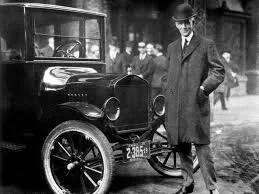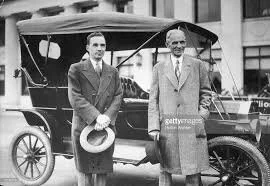Mercury Rising
/Mercury’s path to production was long and arduous and fraught with obstacles. Not the least of which the man whose name was on the building. The great Henry Ford was a brilliant entrepreneur with an obstinate soul. His legendary Model-T was the first automobile to be all at once simple, sturdy and cheap. Because of Henry and the Model-T, virtually anyone who wanted a car could now have one. It forever altered the way the world viewed personal mobility. Lovingly referred to by its owners as the Tin Lizzie, the T made a Michigan farm boy who was good with a wrench into one of history's greatest industrialists.
Henry For with his Model T (Ford Motor Company)
Henry Ford loved his Lizzie and was fiercely protective of her. Henry steadfastly refused to replace the T with a more modern car, keeping it in production more than a decade after it had become obsolete. She had become an obsession, one that nearly brought down his company.
Edsel Bryant Ford was Henry's only son and second in command of the Ford Motor Company. The two could not have been less alike. Henry was tinkerer who loved the down and dirty of the manufacturing process. Edsel was an astute businessman and possessed a fine esthetic and sense of design. Where Henry was crude and confrontational, Edsel was refined and mild-mannered. Henry looked fondly on the glory days past of the Model T. Edsel's view was forward, to a market that was evolving while his company was not. Their disagreements were many. Few had Edsel prevailing over his domineering father.
Edsel and Henry Ford (Ford Motor Company)
By the early 1920s, Ford's main competitor, General Motors, was enjoying tremendous success and profit with its popular mid-priced car lines, Buick, Oldsmobile and later Pontiac. The American public, who once salivated after the simple Model T, had now advanced in both status and income. More and more of them sought an upgrade in comfort, style and power. They wanted more than old Lizzy could give them. Edsel knew his company was missing the boat in this lucrative mid-priced arena. His father, transfixed and obsessed with past success, flatly refused to acknowledge market realities. At the Ford Motor Company, the way Henry Ford saw things was the way they would be.
Well known for his autocratic rule and his paranoia, Henry employed spies all over the company to report unauthorized activities. In the early 1920s, Edsel took advantage of a European trip by the elder Ford to engage in one such endeavor. He ordered trusted men in the design department to craft a modern, low-slung body onto a Model T frame. Edsel reasoned that if he could show his father a complete and functioning prototype, the older Ford would see the wisdom in replacing the T with a more modern car. Through his spies, however, the old man got wind of what was going on. Unannounced, he returned a day early. As the legend goes, Henry Ford walked into the studio before Edsel could get there. Upon seeing the modern looking sports tourer parked on the floor he asked, “Is this a Ford automobile?” After answering in the affirmative, the designers could do nothing but watch in horror as the slight but athletic Mr. Ford took up a sledgehammer and crowbar and proceeded to literally tear the sleek red car apart.
Model T Roadster similar to the one Henry destroyed (www.Carhunz.com)
Perhaps the one trait father and son shared was doggedness. For a dozen more years Edsel struggled to get his obstinate father to see the light, to modernize Ford's product range. For a dozen years old Henry repaid his son's reason with wraith, to the detriment to Edsel's health. He was developing stomach ulcers. But the son’s perseverance did eventually win the day, albeit incrementally. Some years later, the vivid memory of the red roadster’s fate remained as Edsel spearheaded work on a new, smaller Lincoln called the Zephyr. Everyone involved with the project knew that if Henry Ford found out about the new car while it was still in development he would have aborted it in its tracks. They had to use an outside firm to carry out the design work. The resulting car was so stunning, that even Henry when he saw it could not find fault. For the first time Blue Oval customers had a car to bridge the gap between Ford and Lincoln.
1936 Lincoln-Zepher
The 1936 Zephyr, however, was far closer to being Lincoln than a Ford. More steps would be needed to complete Ford Motor Company’s product range. Edsel’s next victory came in the form of the Ford Deluxe. For some time, Ford models had been available with an upgraded trim level. With the 1938 restyle, the Deluxe became its own model range, sporting a nicer interior and distinctive heart-shaped grill. The Deluxe sold well and at a higher profit that standard Fords. That went a long way toward pleasing Henry. Still, there was a nearly $500 price gap between the most expensive Ford Deluxe at $825, and the cheapest Lincoln Zephyr at $1295. It sounds like a pittance today, but in 1938 it was in that very $500 range that nearly every Oldsmobile, Pontiac and Buick was priced. It was in that range that The Ford Motor Company still had nothing to offer.
1938 Ford DeLux (www.gocars.com)
The success of the DeLuxe helped Edsel to finally convince Henry to sign off on a new mid-priced brand. With guidance from Edsel, Ford's gifted chief designer E.T. “Bob” Gregorie created a car that, even though its Ford lineage was apparent, still managed to convey a completely different image, a unique identity that made it a worthy competitor to Oldsmobile and Buick.
1939 Mercury 8
The name Mercury was chosen to evoke the attributes of the Greek God of speed, dependability, eloquence and skill. These were fine qualities and used well in creating the marque’s first car. It used a Ford chassis with the wheelbase stretched by 4 inches. Power came from the company’s well-regarded flat-head V8 engine, Mercury’s version bored out from 221 to 237 cubic inches. Horsepower increased from 85 to 95. This doesn’t sound like much, but a 12% boost made a big difference in the performance and character of the new car. The engine would become a favorite swap-in for hot-rodders of the 1940s and 50s.
Mercury Flathead V8 (www.ebay.com)
The new Mercury 8 was introduced to the public on October 6, 1938. In its first year, 54,000 were built, and 80,000 in the second. 82,000 more Mercurys were produced in 1941 and early ’42 before world war shut down civilian production. The sad irony was that after struggling so mightily to make Mercury a reality, Edsel Ford never saw another one built. The years of battle with his intransigent father were likely the cause of the ulcers and eventual stomach cancer that took his life in the spring of 1943.
Edsel Ford portrait by Diego Rivera








